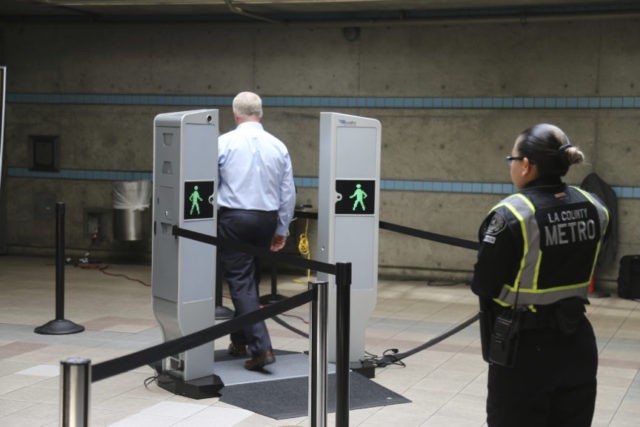Nearly 30 years ago, a young Arnold Schwarzenegger, appearing in a sci-fi movie, Total Recall, walked through an entryway monitored in real-time by thuggish officials, as his skeletal form displayed a firearm hidden under his jacket.
This 1990 theatrical episode is now coming to real-life — and the privacy implications are far from fictional.
Earlier this month, to much fanfare, the Los Angeles County Metropolitan Transportation Authority announced the roll-out of a plan to begin deploying full-body scanners in the city’s subway system. Participating in the roll-out was no less a luminary than the head of the federal Transportation Security Administration (TSA), David Penkoske.
The TSA has long advocated for the use of scanners, not only at commercial airports, but at other travel hubs as well; and its presence at the Los Angeles unveiling as a partner in the project was no surprise. Also of no real surprise, at least to those familiar with the world of privacy-invasive security systems, was the announcement that the technology for the subway scanners was being provided by the British company Thruvision.
As has become the norm whenever the government hits the public with a new form of scan-based security, there were promises that the devices carry no risks to the individuals being scanned. Assurance also were made that the systems will not be overly intrusive. In some respects, such assurances come with a degree of truth. For example, because the devices to be installed rely on scanning waves emitted by the human body (as opposed to radiation emitted by the scanners currently in use at airports), they likely will not carry any risk to those passing through their field of scan. Also, at least as currently planned, the devices will not be deployed at chokepoints through which each subway passenger must pass, so lines probably would not be among the initial drawbacks.
However, anyone who follows the progression of government surveillance systems knows that the vector always travels in one direction – upward to more surveillance, not less. And, since the wavelength scanners unveiled in L.A. currently are capable only of revealing objects on the body of the person passing through the scan field, they would appear unable to pick up a mass hidden not on the individual’s body but in a briefcase or backpack. It only makes sense, then, that the technology will be rapidly enhanced in order to detect other potentially lethal objects being carried by, and not on, individual persons.
Alex Wiggins heads the Los Angeles transit authority, and in his remarks at the August 14th demonstration, he made a not-very-credible stab at assuring the public that once the scanning system was in place, the government surveillors would have no interest if they detected a weapon incapable of inflicting “mass casualties.” He explained that the scanners were “specifically” for the purpose of detecting such things as “explosive vests [and]. . . assault rifles.” Los Angeles is a city that clearly is no friend to persons who carry concealed weapons, and for an official to state that if law enforcement detects a person carrying a handgun onto a subway they will take no action in response, borders on laughable.
Although the city officials touted that being scanned before boarding a subway will be “voluntary,” the price for declining would be that you would not be able to board the train for which you had already paid the fare. As well, you almost certainly would be flagged immediately as a suspicious person because you declined to be scanned. Moreover, assurance that the scanning would be “voluntary” flies in the face of added remarks by the Los Angeles officials, one of who said “most people won’t even know they’re being scanned,” thereby rendering it immaterial whether you “volunteer” since you would not even know enough to make the choice.
During the news conference at the Los Angeles unveiling, there did not appear to have been any interest expressed by the media about who actually will own the information gathered by these and future scanning devices. Had there been such a question, it might have made the government officials as well as Thruvision a mite uncomfortable.
At the end of the day, however, it is likely that most people using ground-based mass transit — whether a subway in Los Angeles or a Greyhound bus in Manhattan — will accept such privacy-invasive scanning as will be deployed very shortly in major cities across the country. As one 22-year old student interviewed in Los Angeles opined, “it makes me feel safe.” And, in the post-911 world, “feeling safe” apparently is worth just about any price.
Bob Barr is president and CEO of the Law Enforcement Education Foundation (LEEF) and a member of the NRA Board of Directors. From 1995-2003, he represented Georgia’s Seventh Congressional District in the U.S. House of Representatives.

COMMENTS
Please let us know if you're having issues with commenting.